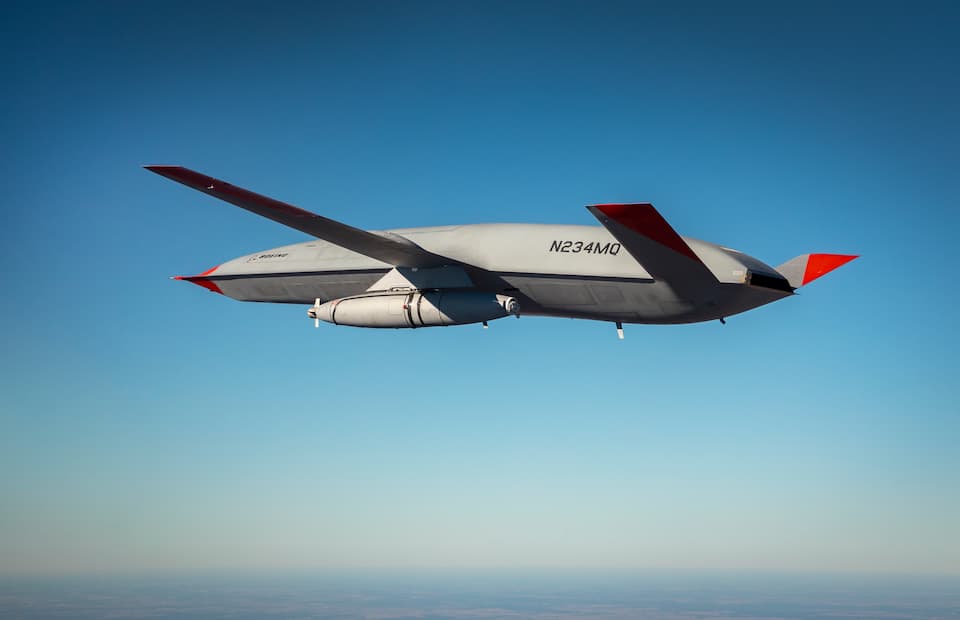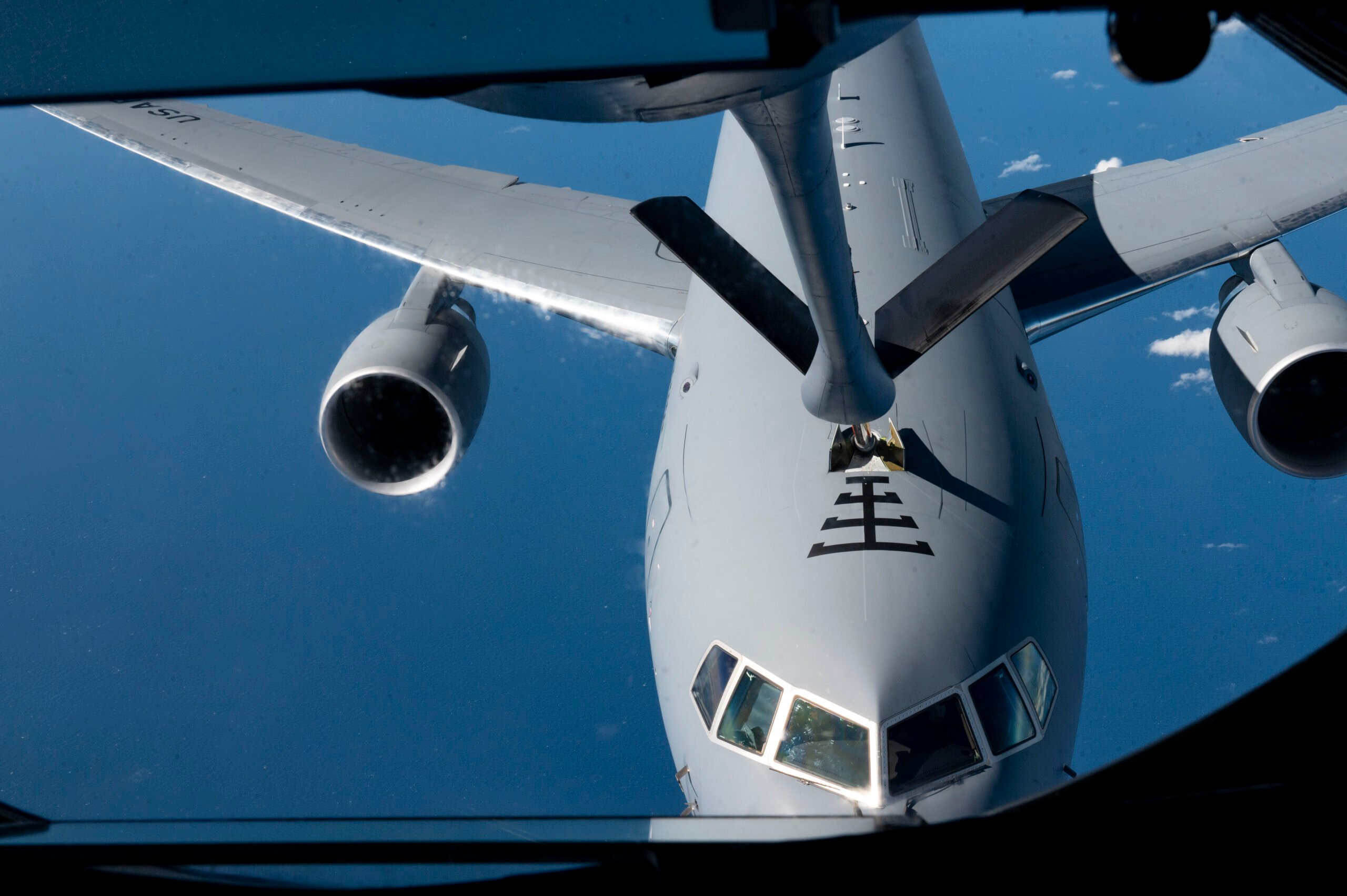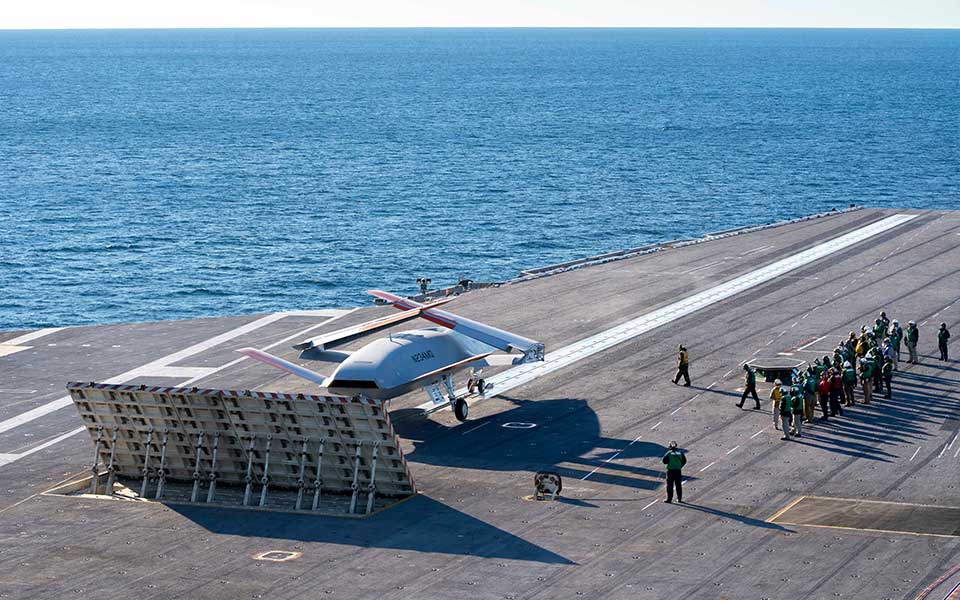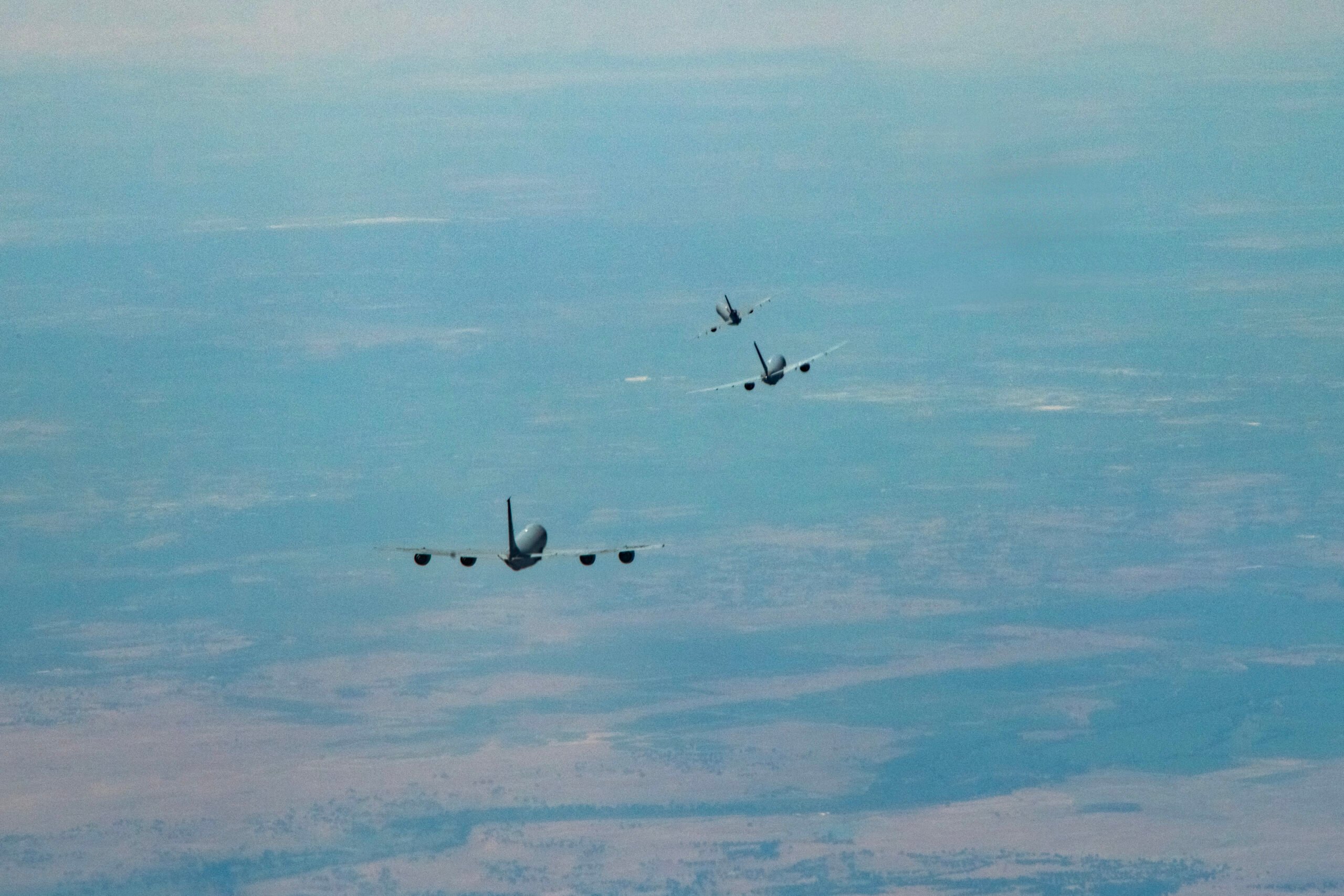
MQ-25 in flight (Photo Courtesy of Boeing).
The aerial refueling mission is evolving radically. For decades, aerial refueling has extended mission range for the joint force fleet with extra fuel for fighters, bombers, cargo and reconnaissance aircraft to fly farther.
Multi-mission versatility and new technology integration enable next-generation tankers to do far more than refueling alone. As these new capabilities are being fielded, an emerging team of systems approach to aerial refueling makes a variety of mission capability options possible for the warfighter and creates multiple challenges for adversaries.
Boeing’s KC-46A Pegasus and MQ-25TM StingrayTM already demonstrate the advanced capabilities that the world’s most advanced tankers bring to the fleet today and serve as operational pathfinders for a next-generation aerial refueling team of systems as the joint force pushes to stay ahead of near-peer threats.
Here are five examples of how the KC-46A and MQ-25 are transforming the role of the tanker to maximize future aerial refueling mission sets.
Agile throughout the theater and at the threat space
Historically, tankers were designed to provide fuel outside of threat range, distanced from the tactical edge. As near-peer range and lethality have increased—and time on target becomes ever more crucial—maximizing maneuverability throughout the operational theater has become critical to the future battle. Both the KC-46A Pegasus and MQ-25 Stingray showcase the agility necessary to support assets closer to the fight.
The KC-46A tanker can access more small bases, austere airfields and limited runways and also features unprecedented combat-ready defensive systems and countermeasures to detect, avoid, defeat and survive threats. Because it can launch from dispersed locations and operate in contested environments, the KC-46A facilitates ‘more booms in the air’—more refuelers spread throughout the operational theater and closer to the battlespace. The KC-46 ensures warfighters have quicker, closer access to fuel, so they can stay in the fight where they are needed.
Unlike many existing and legacy strategic tankers, the KC-46A can also receive fuel, which significantly extends the range and flexibility of global mobility and power projection maneuvers.

A U.S. Air Force KC-135 Stratotanker refuels a KC-46 Pegasus over the Indo-Pacific region during the Mobility Guardian 23 exercise. The Pegasus’s ability receive fuel extends the maneuverability of the fleet. (U.S. Air Force photo: Tech. Sgt. Heather Clements)
The MQ-25 is the first unmanned carrier-based aerial refueler. Unmanned tanking capability is a force multiplier that frees up the U.S. Navy’s strike fighters and pilots currently carrying out the tanking role. The MQ-25’s aerial refueling capability extends the range, interoperability and lethality of the Carrier Air Wing and Carrier Strike Group, while also providing intelligence, surveillance and reconnaissance (ISR) capability. The Navy plans for all NIMITZ and FORD-class carriers to be MQ-25 capable.
Data connectivity and situational awareness
As recent conflicts have shown, situational awareness and the ability to share information throughout the joint force is imperative in the modern battlespace. Next-gen tankers deliver data as well as fuel to the fight.
Loitering on station at the tactical edge (thanks to its defensive systems), the KC-46A is an ideal connectivity hub, exchanging data with receivers and multi-domain warfighters. The tanker can relay integrated tactical situational awareness to the joint force for real-time information superiority and decision-making advantage.
The KC-46A has already been described as “game changer” for its ability to transmit and exchange data; and a Block 1 upgrade will add more advanced communications capabilities to further enhance the aircraft’s data connectivity and situational awareness.
In addition, Boeing is studying the integration of Advanced Battle Management System (ABMS) capabilities onto the KC-46A Pegasus tanker.
For the Navy, MQ-25 provides communication and intelligence gathering capabilities in addition to refueling. The platform is designed to operate forward with the Carrier Air Wing. MQ-25 connectivity also extends back to the carrier with the ability to provide situational awareness at long range and with endurance exceeding other carrier-based platforms.
Multi-mission versatility for rapid global mobility
Along with fuel and data for the fight, strategic tankers must also deliver rapid global mobility with cargo, passenger and aeromedical transportation—crucial capabilities for moving the joint force throughout dispersed locations.
Compared to the Boeing-built KC-135 Stratotanker, which has been delivering fuel and multi-mission transport for the fleet for more than 65 years, the KC-46A carries three times more standard military cargo pallets, twice as many passengers and 30% more aeromedical evacuation patient capacity. In fact, the KC-46A can carry 18 military standard cargo pallets—as many as the C-17 Globemaster III!
What’s more, the KC-46A can convert between cargo, passenger and aeromedical evacuation modes in just two hours, compared to five hours in competing tankers—with emergency oxygen and electrical power for medevac support included — and is completely compatible with the U.S. Department of Defense Transportation System.
Autonomous Capability
Operator-assisted automation are rapidly emerging operational capabilities for aerial refueling. Boeing teams are focused on these technologies and, just as importantly, on developing the concept of operations as these capabilities are integrated into the world’s largest aerial refueling fleets and within the relevant regulatory framework.
MQ-25 is the world’s first unmanned aerial refueler having successfully demonstrated autonomous refueling with F/A-18 and F-35C. The platform will serve as a pathfinder for safely integrating autonomy with manned squadrons as well as into the dynamic carrier deck environment.

MQ-25 on carrier deck (Photo Courtesy of Boeing).
The KC-46 program is maturing and demonstrating Autonomous Air-to-Air Refueling (A3R) via the aerial refueling boom. The program’s Model Based Engineering (MBE) approach used iterative high-fidelity flight-validated simulations, an end-to-end hardware-in-the-loop laboratory, and flight demonstrations in various aerial refueling scenes and environmental conditions to mature A3R technology.
Both platforms demonstrate the pathways that will help refueling fleets to determine whether, when and how to integrate autonomous capability to best support their missions.
Lifecycle Sustainment and Mission-Readiness
As Boeing’s KC-135 flies toward its eighth decade of service, the lifecycle value of refueling platforms has never been more evident. Building on that legacy, today’s leading tankers are designed and manufactured with an eye on sustainment and mission versatility over their lifespan.
The KC-46A’s in-line production system on Boeing’s 767 line in Everett, Washington—supported by a network of more than 650 U.S. suppliers—integrates mission systems directly into the aircraft, building the Pegasus as a combat-ready multi-mission tanker from day one. In-line production reduces airframe corrosion that can occur in post-production modification, giving the KC-46A a longer lifespan and reducing lifetime maintenance costs.
Boeing builds the KC-46A with capacity to integrate cutting-edge capabilities as the needs of the mission evolve. The Pegasus’s Block 1 data and communications connectivity upgrades exemplify how it adds new capabilities to keep pace with the mission.

As the U.S. Air Force celebrated 100 years of aerial refueling with Operation Centennial Contact, a KC-135 Stratotanker, nearest, KC-46A Pegasus, center, and a KC- 10 Extender fly in formation above Travis Air Force Base, California, the sixth main operating base for the Pegasus. The KC-46A’s connectivity and survivability demonstrate the capabilities that are redefining the aerial refueling mission for the next 100 years. (U.S. Air Force photo by Heide Couch)
The MQ-25 skins are another example of applying advanced manufacturing for operational and lifecycle benefits. The composite skins—produced by Aurora Flight Sciences in Mississippi—provide lightweight strengthening and anti-corrosive benefits that are crucial for the aircraft, which will be based on aircraft carriers in harsh ocean conditions.
From a growth perspective, MQ-25 was developed with provisions to ensure it can evolve with the Navy’s operational needs. Boeing is actively partnering with the Navy to develop next generation capabilities, which will take the platform closer to the fight.
The Future of Aerial Refueling Today
The KC-46A and MQ-25 Stingray provide agility, connectivity, survivability and sustainability for today’s fight and evolutionary capabilities for the future battlespace. These platforms open up new mission sets and demonstrate how Boeing delivers aerial refueling innovation necessary for the next-generation aerial refueling team of systems.
The appearance of U.S. Department of Defense (DoD) visual information does not imply or constitute DoD endorsement.
NAVAIR Public Release 2023-590 Distribution Statement A – “Approved for public release; distribution is unlimited”





















